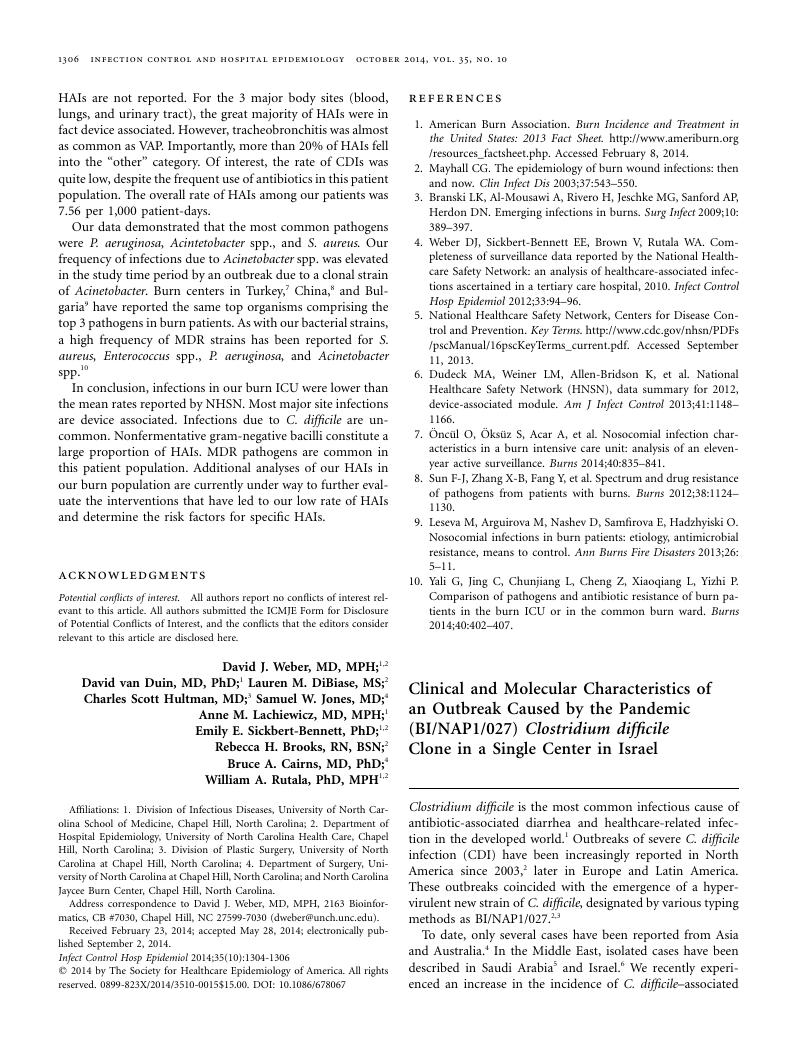Crossref Citations
This article has been cited by the following publications. This list is generated based on data provided by Crossref.
Adler, Amos
Miller-Roll, Tamar
Bradenstein, Rita
Block, Colin
Mendelson, Bracha
Parizade, Miriam
Paitan, Yossi
Schwartz, David
Peled, Nehama
Carmeli, Yehuda
and
Schwaber, Mitchell J.
2015.
A national survey of the molecular epidemiology of Clostridium difficile in Israel: the dissemination of the ribotype 027 strain with reduced susceptibility to vancomycin and metronidazole.
Diagnostic Microbiology and Infectious Disease,
Vol. 83,
Issue. 1,
p.
21.
Cheng, Jing-Wei
Xiao, Meng
Kudinha, Timothy
Xu, Zhi-Peng
Hou, Xin
Sun, Lin-Ying
Zhang, Li
Fan, Xin
Kong, Fanrong
and
Xu, Ying-Chun
2016.
The First Two Clostridium difficile Ribotype 027/ST1 Isolates Identified in Beijing, China–an Emerging Problem or a Neglected Threat?.
Scientific Reports,
Vol. 6,
Issue. 1,
Miller-Roll, Tamar
Na'amnih, Wasef
Cohen, Dani
Carmeli, Yehuda
and
Adler, Amos
2016.
Molecular types and antimicrobial susceptibility patterns of Clostridium difficile isolates in different epidemiological settings in a tertiary care center in Israel.
Diagnostic Microbiology and Infectious Disease,
Vol. 86,
Issue. 4,
p.
450.
Cairns, M. D.
Preston, M. D.
Hall, C. L.
Gerding, D. N.
Hawkey, P. M.
Kato, H.
Kim, H.
Kuijper, E. J.
Lawley, T. D.
Pituch, H.
Reid, S.
Kullin, B.
Riley, T. V.
Solomon, K.
Tsai, P. J.
Weese, J. S.
Stabler, R. A.
Wren, B. W.
and
Carroll, Karen C.
2017.
Comparative Genome Analysis and Global Phylogeny of the Toxin Variant Clostridium difficile PCR Ribotype 017 Reveals the Evolution of Two Independent Sublineages.
Journal of Clinical Microbiology,
Vol. 55,
Issue. 3,
p.
865.
Saha, Srishti
Kapoor, Saloni
Tariq, Raseen
Schuetz, Audrey N.
Tosh, Pritish K.
Pardi, Darrell S.
and
Khanna, Sahil
2019.
Increasing antibiotic resistance in Clostridioides difficile: A systematic review and meta-analysis.
Anaerobe,
Vol. 58,
Issue. ,
p.
35.
Pu, Meng
Cho, Janice M.
Cunningham, Scott A.
Behera, Gaurav K.
Becker, Sarah
Amjad, Talal
Greenwood-Quaintance, Kerryl E.
Mendes-Soares, Helena
Jones-Hall, Yava
Jeraldo, Patricio R.
Chen, Jun
Dunny, Gary
Patel, Robin
and
Kashyap, Purna C.
2021.
Plasmid Acquisition Alters Vancomycin Susceptibility in Clostridioides difficile.
Gastroenterology,
Vol. 160,
Issue. 3,
p.
941.
Brajerova, Marie
Zikova, Jaroslava
and
Krutova, Marcela
2022.
Clostridioides difficile epidemiology in the Middle and the Far East.
Anaerobe,
Vol. 74,
Issue. ,
p.
102542.



